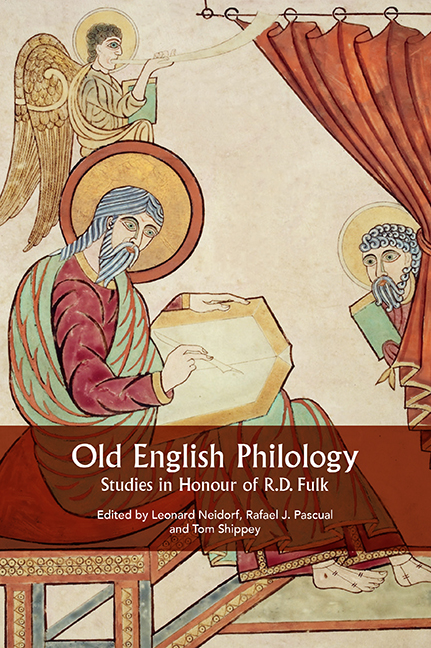Book contents
- Frontmatter
- Contents
- List of Illustrations
- Acknowledgements
- List of Contributors
- Introduction: R.D. Fulk and the Progress of Philology
- 1 Sievers, Bliss, Fulk, and Old English Metrical Theory
- 2 Ictus as Stress or Length: The Effect of Tempo
- 3 Metrical Criteria for the Emendation of Old English Poetic Texts
- 4 The Suppression of the Subjunctive in Beowulf: A Metrical Explanation
- 5 Metrical Complexity and Verse Placement in Beowulf
- 6 Alliterating Finite Verbs and the Origin of Rank in Old English Poetry
- 7 Prosody-Meter Correspondences in Late Old English and Poema Morale
- 8 The Syntax of Old English Poetry and the Dating of Beowulf
- 9 The Anglo-Saxons and Superbia: Finding a Word for it
- 10 Old English gelōme, gelōma, Modern English loom, lame, and Their Kin
- 11 Worm: A Lexical Approach to the Beowulf Manuscript
- 12 Wulfstan, Episcopal Authority, and the Handbook for the Use of a Confessor
- 13 Some Observations on e-caudata in Old English Texts
- 14 The Poetics of Poetic Words in Old English
- 15 Dream of the Rood 9b: A Cross as an Angel?
- 16 The Fate of Lot’s Wife: A ‘Canterbury School’ Gloss in Genesis A
- 17 Metrical Alternation in The Fortunes of Men
- 18 The Originality of Andreas
- 19 The Economy of Beowulf
- 20 Beowulf Studies from Tolkien to Fulk
- The Writings of R.D. Fulk
- Index
- Tabula Gratulatoria
- Anglo-Saxon Studies
10 - Old English gelōme, gelōma, Modern English loom, lame, and Their Kin
Published online by Cambridge University Press: 29 May 2021
- Frontmatter
- Contents
- List of Illustrations
- Acknowledgements
- List of Contributors
- Introduction: R.D. Fulk and the Progress of Philology
- 1 Sievers, Bliss, Fulk, and Old English Metrical Theory
- 2 Ictus as Stress or Length: The Effect of Tempo
- 3 Metrical Criteria for the Emendation of Old English Poetic Texts
- 4 The Suppression of the Subjunctive in Beowulf: A Metrical Explanation
- 5 Metrical Complexity and Verse Placement in Beowulf
- 6 Alliterating Finite Verbs and the Origin of Rank in Old English Poetry
- 7 Prosody-Meter Correspondences in Late Old English and Poema Morale
- 8 The Syntax of Old English Poetry and the Dating of Beowulf
- 9 The Anglo-Saxons and Superbia: Finding a Word for it
- 10 Old English gelōme, gelōma, Modern English loom, lame, and Their Kin
- 11 Worm: A Lexical Approach to the Beowulf Manuscript
- 12 Wulfstan, Episcopal Authority, and the Handbook for the Use of a Confessor
- 13 Some Observations on e-caudata in Old English Texts
- 14 The Poetics of Poetic Words in Old English
- 15 Dream of the Rood 9b: A Cross as an Angel?
- 16 The Fate of Lot’s Wife: A ‘Canterbury School’ Gloss in Genesis A
- 17 Metrical Alternation in The Fortunes of Men
- 18 The Originality of Andreas
- 19 The Economy of Beowulf
- 20 Beowulf Studies from Tolkien to Fulk
- The Writings of R.D. Fulk
- Index
- Tabula Gratulatoria
- Anglo-Saxon Studies
Summary
… inside he could see women with a loom set up before them. Men's heads were used instead of weights ….
Njal's Saga, Chapter 157… no looms here, no dissent …
George Eliot, MiddlemarchWith deadline looming, complex issues remain.
From a newspaper, July 4, 2005When we encounter ancient homonyms, it is always tempting to trace them to the same etymon. As is known, Jacob Grimm found this approach rewarding. Below, an attempt will be made to find out whether Mod. Engl.* loom ‘weaving machine’, a stub of weblōme, as Skeat (1901: 173, originally published in 1885) was the first to show, is related to OE gelōme ‘often,’ memorable especially from the tautological binomial oft and gelōme. Then there is the verb loom ‘to move slowly up and down; appear indistinctly’; its possible ties to loom / gelōme also have to be investigated.*
Earlier, the noun loom meant ‘tool; bucket, tub, etc.,’ from OE gelōma ‘utensil, implement.’ Obviously, ‘bucket’ and other words for ‘vessel’ were occasional semes. No one doubts that gelōma had a collective meaning (something like ‘stuff’?); the prefix ge- is transparent, yet the noun referred to single objects. In AeEW, gelōma and gelōme stand in adjacent lines, and about both words Holthausen says “of unknown origin”; he does not even suggest that they can be cognate. I will return to his conclusion at the end of the paper. ODEE (at loom) cites OE andlōman, pl. ‘apparatus, furniture.’ OED adds that the ulterior etymology of loom is obscure, but that some people thought of a connection with OE gelōme (OHG kilômo) and reconstructed the primary meaning as ‘things in frequent use.’ I am not sure who those “some people” are and have seen this reconstruction only in CD. Its etymological editor (Charles P.G. Scott) expressed little confidence in the idea he mentioned.
Old dictionaries, which groped their way through chance look-alikes, were usually reticent when it came to loom; at best, they cited the Old English form. One approach to the sought-for etymology can be rejected as certainly wrong: the loom did not get its name because it wove, produced yarn, or had something to do with clothing.
- Type
- Chapter
- Information
- Old English PhilologyStudies in Honour of R.D. Fulk, pp. 190 - 199Publisher: Boydell & BrewerPrint publication year: 2016



